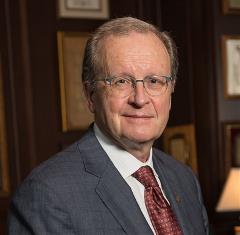Goran B. Klintmalm, MD, PhD
 Ever since its creation in 1974, ASTS has been the forum for transplant surgeons, not only from the U.S. but from around the world, to communicate with the purpose of developing the then experimental discipline of organ transplantation into a clinical science that could save lives. However, even now established therapy is not perfect. There are still innumerable questions that await answers. And ASTS is here providing the opportunity for creative communication between all involved. In addition, it is the only true voice of the transplant surgeons, representing us when working with Congress, HRSA, CMS, FDA, etc.
Ever since its creation in 1974, ASTS has been the forum for transplant surgeons, not only from the U.S. but from around the world, to communicate with the purpose of developing the then experimental discipline of organ transplantation into a clinical science that could save lives. However, even now established therapy is not perfect. There are still innumerable questions that await answers. And ASTS is here providing the opportunity for creative communication between all involved. In addition, it is the only true voice of the transplant surgeons, representing us when working with Congress, HRSA, CMS, FDA, etc.
In 2007 when I was treasurer for ASTS, I realized that the pharmaceutical industry which had enabled the transplant community to develop organ transplantation since the late 1970s would probably not be able to do so much longer. Thus I proposed for the ASTS Foundation to build up a fund of $20 million, which would be sufficient to support our annual meetings such as ATC and the Winter Symposium. In addition, it would give us the ability to support young promising investigators with research funding that would lead them to a career of academic investigation. This proposal was passed by the Council. Ten years later, we are actually very close to reaching this goal.
For myself, it has always been my belief and desire to support activities that benefit the society we live within—and especially ASTS which has been central in my entire professional life ever since my first ASTS meeting at the Drake Hotel in Chicago, in May of 1980. There were fewer than 150 surgeons and investigators from around the world who met. The traditional friendly sparring between Starzl and Najarian was one of the fun highlights of the meeting. Tom Starzl presented our pioneering results from Denver using cyclosporin in livers and kidneys and of course so did Roy Calne from Cambridge. It was electrifying, as was the dinner at Fred Merkel’s lakeside home Friday evening for all the attendees. Having an informal, outdoor dinner with virtually all the famous investigators in the world was a dream for a young fellow.
The contributions from the ASTS membership are absolutely essential to propagating our Society into the future. It gives us the ability to support and develop future transplant surgeons, and not less important, to be on the barricades flying the flag with the chimera logo, representing us in a rapidly changing world.
I urge all of you to reach out to the ASTS Foundation with a contribution. Make it part of your legacy as a transplant surgeon.
